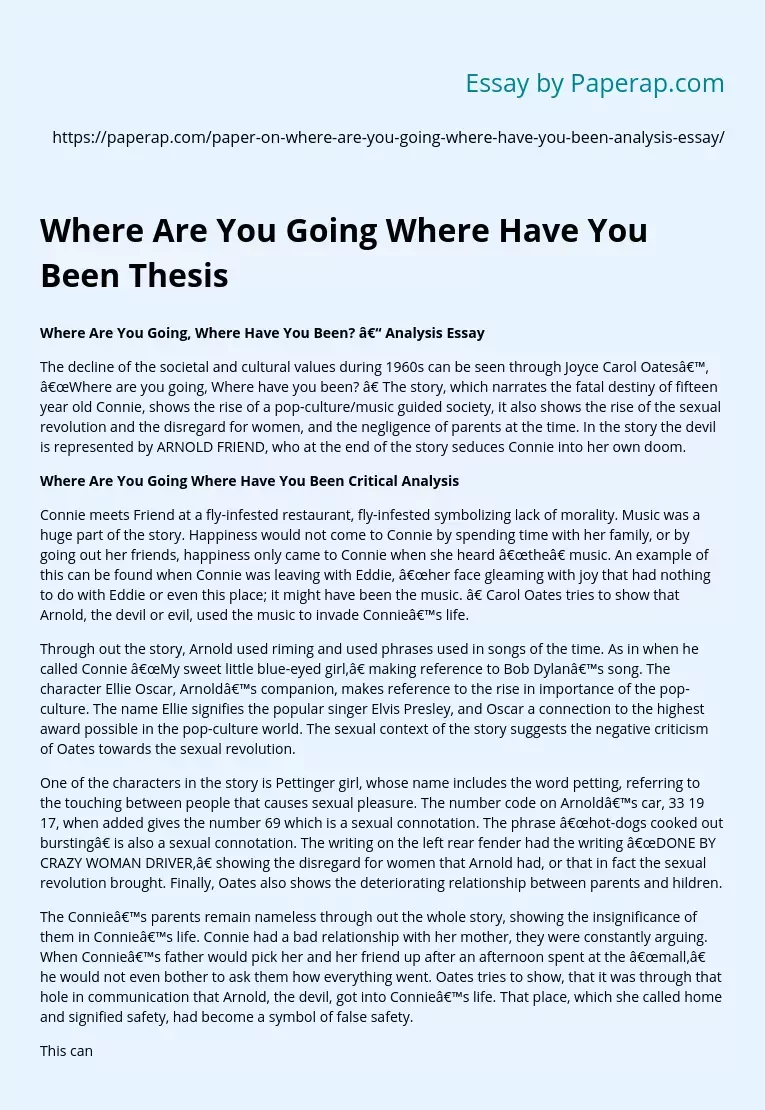Where Are You Going Where Have You Been Thesis
Where Are You Going, Where Have You Been? – Analysis Essay
The decline of the societal and cultural values during 1960s can be seen through Joyce Carol Oates’, “Where are you going, Where have you been? ” The story, which narrates the fatal destiny of fifteen year old Connie, shows the rise of a pop-culture/music guided society, it also shows the rise of the sexual revolution and the disregard for women, and the negligence of parents at the time. In the story the devil is represented by ARNOLD FRIEND, who at the end of the story seduces Connie into her own doom.
Where Are You Going Where Have You Been Critical Analysis
Connie meets Friend at a fly-infested restaurant, fly-infested symbolizing lack of morality. Music was a huge part of the story. Happiness would not come to Connie by spending time with her family, or by going out her friends, happiness only came to Connie when she heard “the” music. An example of this can be found when Connie was leaving with Eddie, “her face gleaming with joy that had nothing to do with Eddie or even this place; it might have been the music.
” Carol Oates tries to show that Arnold, the devil or evil, used the music to invade Connie’s life.
Through out the story, Arnold used riming and used phrases used in songs of the time. As in when he called Connie “My sweet little blue-eyed girl,” making reference to Bob Dylan’s song. The character Ellie Oscar, Arnold’s companion, makes reference to the rise in importance of the pop-culture.
The name Ellie signifies the popular singer Elvis Presley, and Oscar a connection to the highest award possible in the pop-culture world. The sexual context of the story suggests the negative criticism of Oates towards the sexual revolution.
One of the characters in the story is Pettinger girl, whose name includes the word petting, referring to the touching between people that causes sexual pleasure. The number code on Arnold’s car, 33 19 17, when added gives the number 69 which is a sexual connotation. The phrase “hot-dogs cooked out bursting” is also a sexual connotation. The writing on the left rear fender had the writing “DONE BY CRAZY WOMAN DRIVER,” showing the disregard for women that Arnold had, or that in fact the sexual revolution brought. Finally, Oates also shows the deteriorating relationship between parents and hildren.
The Connie’s parents remain nameless through out the whole story, showing the insignificance of them in Connie’s life. Connie had a bad relationship with her mother, they were constantly arguing. When Connie’s father would pick her and her friend up after an afternoon spent at the “mall,” he would not even bother to ask them how everything went. Oates tries to show, that it was through that hole in communication that Arnold, the devil, got into Connie’s life. That place, which she called home and signified safety, had become a symbol of false safety.
This can be seemed through this phrase, “this place you are now—inside your daddy’s house—is nothing but a cardboard I can knock down any time. ” “Where are you going, where have you been,” is a big criticism towards the 1960s society and culture. To Oates the deteriorating moral value was caused by the rise in importance of the pop-culture, which in some form led Connie into her doom, and the lack of communication between parents and kids. Oates’ opposition to the sexual revolution is also evident in the story.
Where Are You Going Where Have You Been Thesis. (2019, Nov 27). Retrieved from https://paperap.com/paper-on-where-are-you-going-where-have-you-been-analysis-essay/

